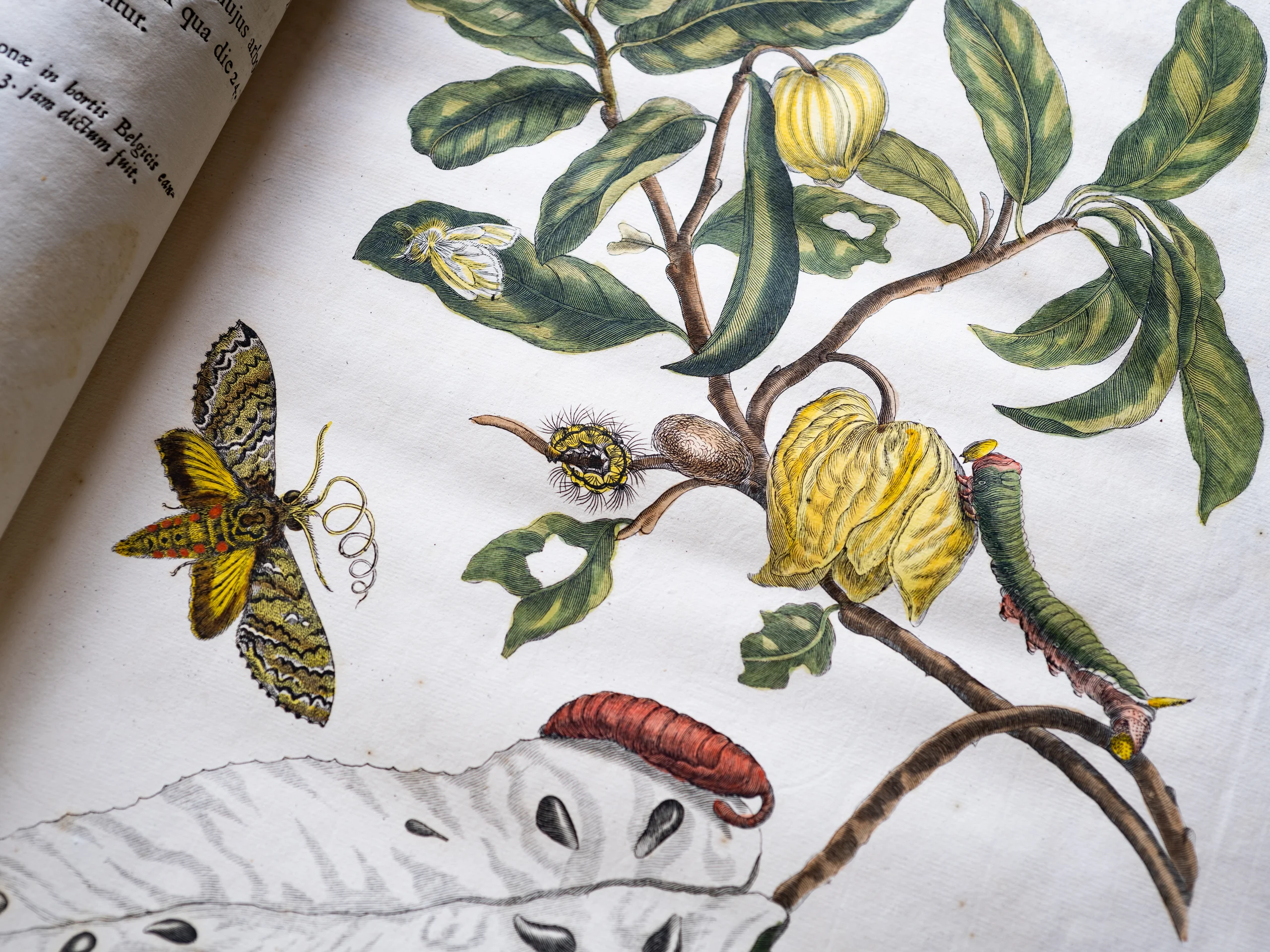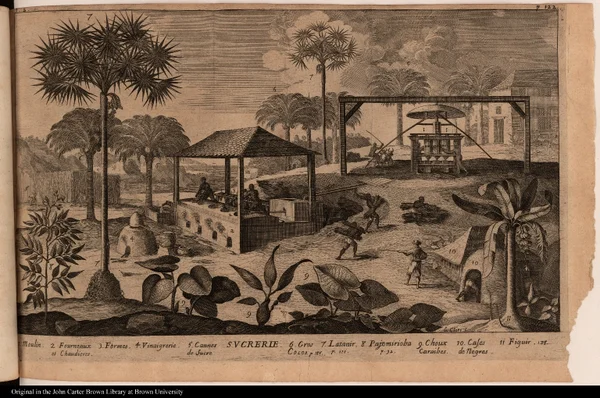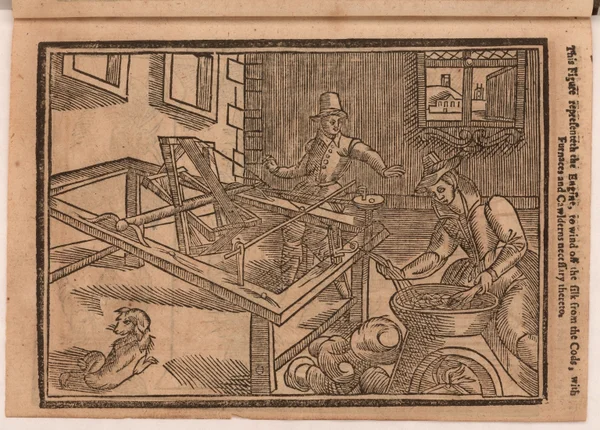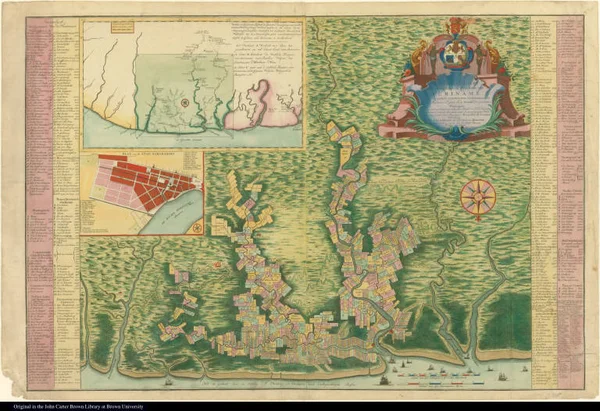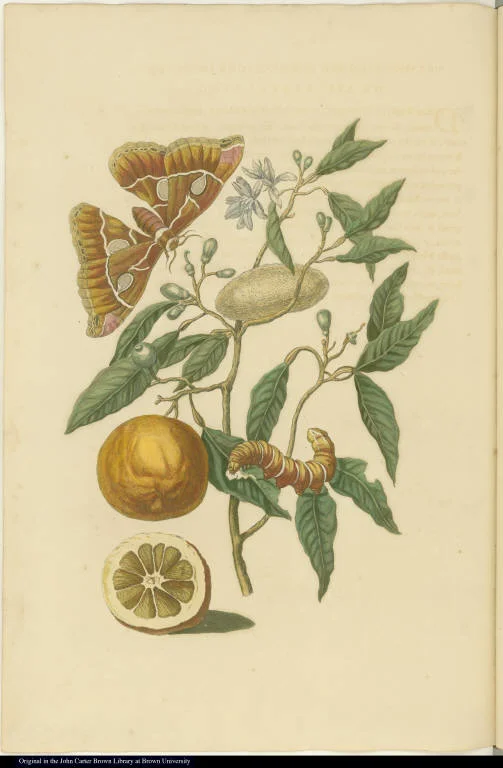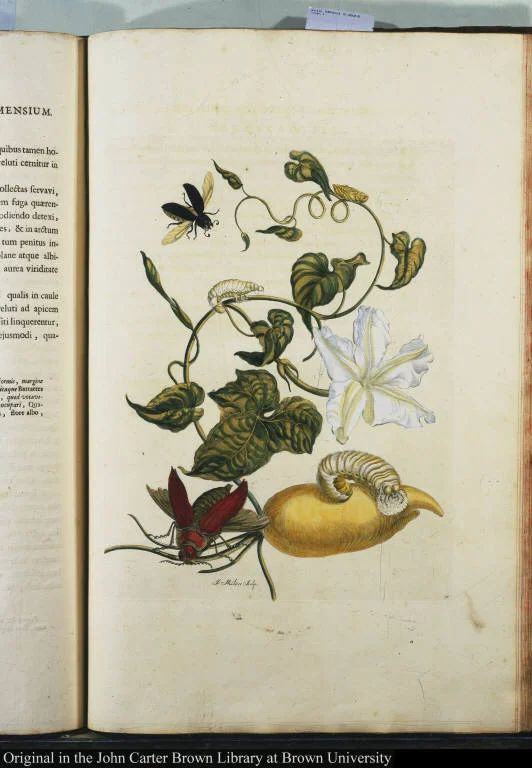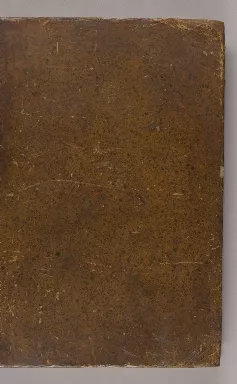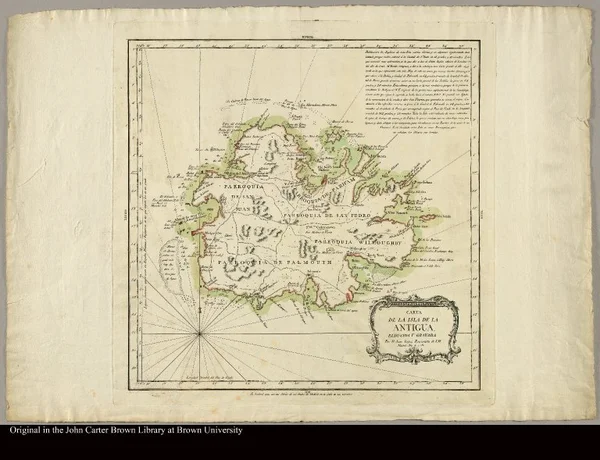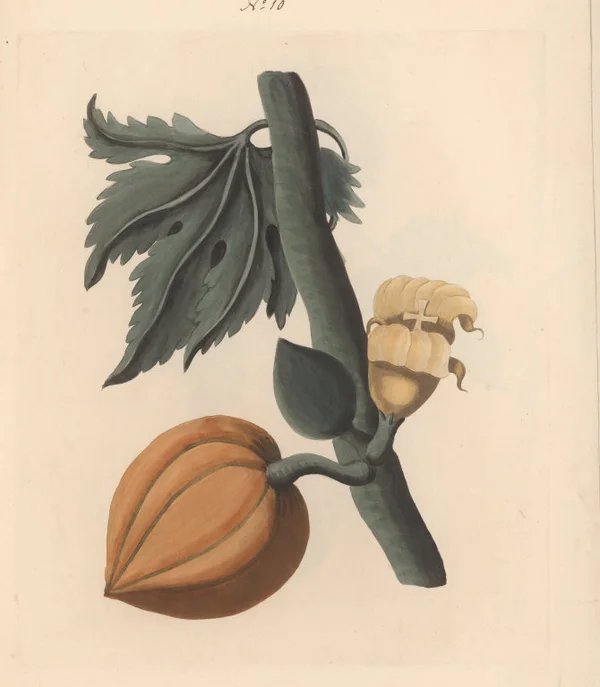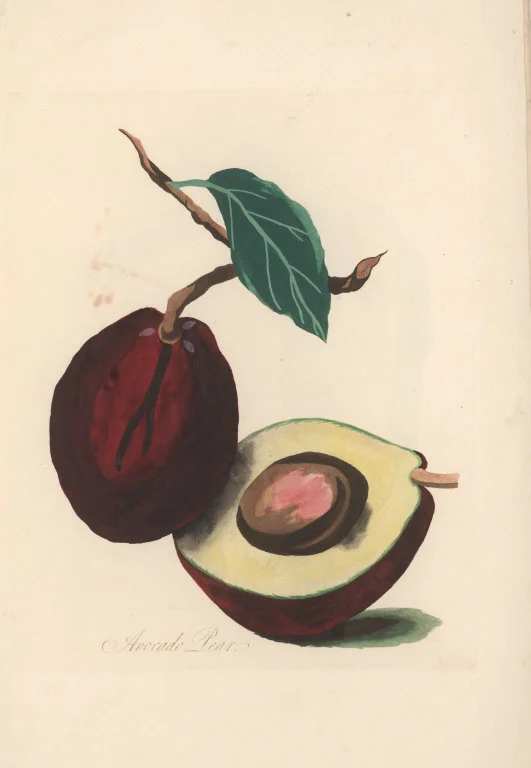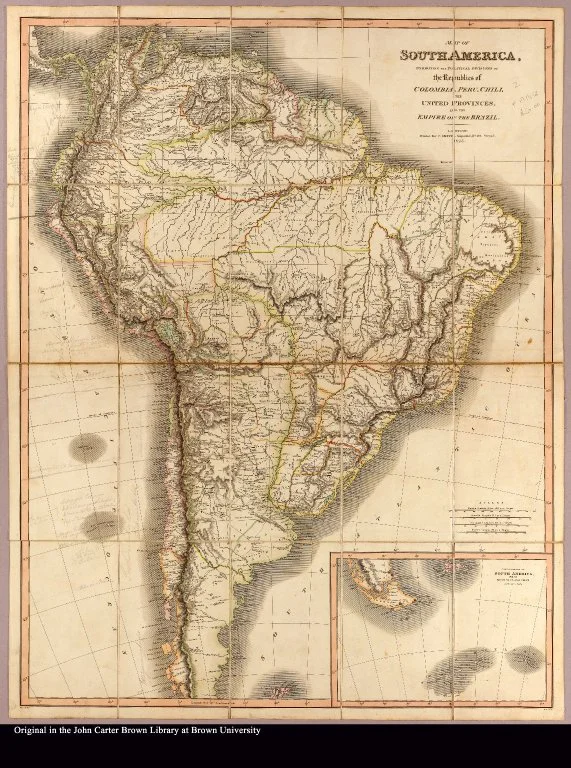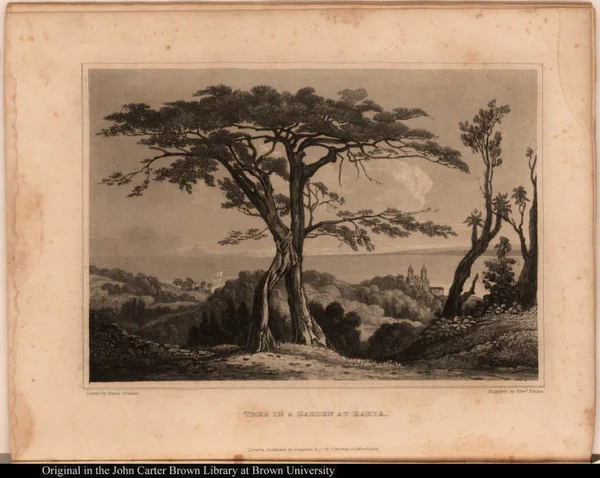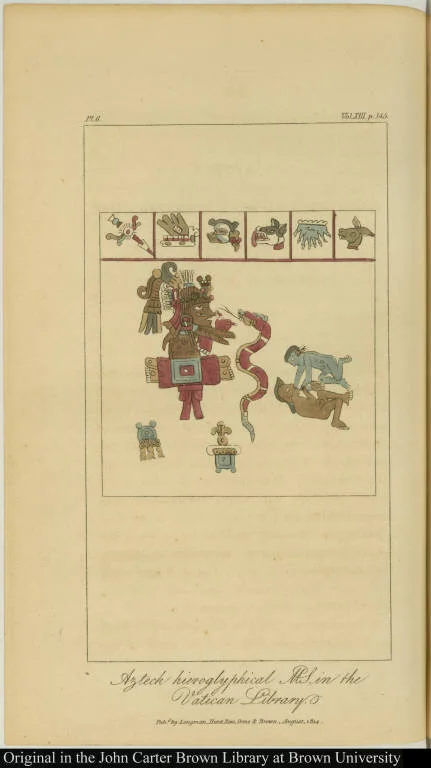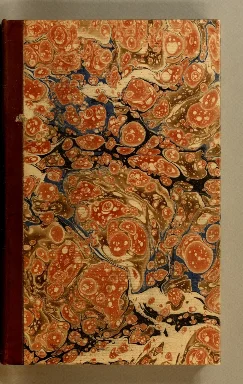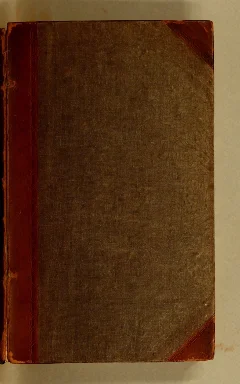Insects in the Americas
Sucrerie
1651-1700
-
 p. 1
p. 1Virginia Ferrar (1627?-1688) was an English bookbinder and sericulturalist (someone who cultivates silkworms). She was named after the colony of Virginia; her father, John Ferrar, had been deputy of the Virginia Company of London, which sought to establish colonial settlements in North America. John Ferrar aimed to stimulate a silk industry in Virginia, and so he encouraged Virginia to the cultivation of silkworms from their family home in England. Virginia also corresponded with Virginians, some of whom would send her silkworm cocoons from the colony. The JCB holds several books related to Virginia and John Ferrar’s work on silkworms. These books provide a fascinating glimpse into the life of a seventeenth-century female sericulturalist and her participation in transatlantic networks of knowledge exchange.
[Winding silk from the cocoons]
1601-1650
-
 p. 1
p. 1In the 16th and 17th centuries Europeans began to turn to insects as a new field of study. This was further stimulated by the work of, among others, Antoni van Leeuwenhoek (1632-1723), who used the microscope to study the morphology of insects, and Jan Swammerdam (1637-1680), who made important discoveries on the anatomy of insects. European interest in insects also grew because of the increasing number of travellers bringing back zoological specimens from overseas voyages of exploration. The JCB houses the works of Virginia Ferrar (1627?-1688) and Maria Sibylla Merian (1747-1717), two European women whose captivating work on insects both reflected and shaped this unfolding field.
Algemeene Kaart van de Colonie of Provintie van Suriname, ...
1758
-
 p. 1
p. 1Maria Sibylla Merian (1647-1717) was a German-born naturalist and scientific illustrator. Merian held a lifelong fascination for insects. From the age of thirteen, she collected and bred caterpillars, studying their behavior and transformation into moths and butterflies. In 1699, she travelled to the Dutch colony of Suriname with her daughter to further her entomological research. For two years Merian travelled, collected, studied, and sketched, until ill health forced her to return to Europe.
[Orange tree and insects]
1701-1750
-
 p. 1
p. 1She published the results of her research in the Metamorphosis Insectorum Surinamensium (1705), which contained 60 copperplates and accompanying descriptions of the insects and plants of Surinam. Many of the insects she described were new to Europeans, and she was the first naturalist to depict insects and their host plants together in one composition, making this one of the earliest tropical ecology studies. She is still admired today for her scientific contributions and the exceptional artistic quality of her work.
Battattes albicantes
1701-1750
-
 p. 1
p. 1The 1705 edition of the Metamorphosis Insectorum Surinamensium was published in both Latin and in Dutch. It was reprinted in 1719, two years after Merian’s death. The JCB holds three copies of the 1719 edition, two in Latin and one in Dutch. This edition contains 12 additional engraved plates. Merian’s illustrations of butterflies and moths were unique for capturing the different stages of their metamorphosis – caterpillar, cocoon, butterfly or moth – in a single image. Even after 300 years, the eye for detail (look at how the caterpillar has been chewing on the leaves!) and the vibrancy of the colours are breath-taking.
Mariae Sibillae Merian Dissertatio de generatione et metamorphosibus ins...
1719
-
 p. 17
p. 17In a counterproof, the outlines of the image are softer and there are no platemarks on the page, which makes it look more like an original watercolour.
The Flora and Fauna of the Caribbean
Carta de la isla de la Antigua reducida y gravada por D. Juan Lopez, Pen...
1780
-
 p. 1
p. 1In a section titled ‘Sketch of the Natural History of Antigua’, Riddell provides a scientific description of the plants on that island. She used the classification system of Swedish naturalist Carl Linnaeus to identify and categorize her findings. Listed in alphabetical order, entries contain extensive information on the appearance, flavour, and usefulness of a wide variety of plants. She probably gained a lot of botanical information from discussions with local inhabitants. With the publication of her book this local knowledge was mediated to European audiences.
-
 p. 1
p. 1The ‘Sketch of the Natural History of Antigua’ also includes a scientific description of the different kinds of animals she encountered there. Since zoology was largely considered to be a male domain in this period, Riddell was challenging traditional gender roles with the publication of her work. She based her zoological descriptions not on Linnaeus’ classification system, as was customary at the time, but on that of naturalist and fellow countryman Thomas Pennant.
No. X. Carica papaya, or, Papaw tree; The female tree. The Leaves of thi...
1751-1800
-
 p. 1
p. 1A collection of exotics, from the island of Antigua was printed in London around 1797. Byam’s name does not appear in print; instead, the author is indicated as ‘By a Lady’. The work has been ascribed to Byam because the initials ‘L.B.’ were written in pencil on the title page of a copy held by another collection. The book consists of four pages of short botanical descriptions, followed by accompanying plates of hand-colored engravings.
Avocado Pear.
1751-1800
-
 p. 1
p. 1In 1800, Byam published A collection of fruits from the West Indies: drawn and colored from nature, and, with permission, most humbly dedicated to the Princess Elizabeth. This work consists of nine hand-colored engraved plates depicting different fruits "drawn from nature" and growing in the West Indies, such as the rose apple, avocado pear, cashew, and granadilla. Each plate has a caption identifying the plant.
-
 p. 1
p. 1There are striking similarities between Byam’s and Riddell’s descriptions of Antiguan plants (replicated below). One possible reason for this is that they both used the Linnaean scheme for naming plants. Another explanation may be that Byam drew inspiration from Riddell’s work, which had been published only a few years previously. Could the two women have known each other? Riddell does record a visit to a Byam family on Antigua in her Voyages, but there is no mention of a Lydia Byam, and there is no other evidence to suggest that they crossed paths. Nonetheless, it is intriguing to imagine these two women as forming part of a larger female network of scientific exchange.
Sketches of Latin America
Map of South America, exhibiting the political divisions of the republic...
1825
-
 p. 1
p. 1Marian Graham
Maria Graham (née Dundas, later Lady Callcott, 1785-1842) was a British traveller and author. Graham travelled to South America in 1821 with her husband Thomas Graham, a Royal Navy captain whose job it was to protect British mercantile interests along the South American coast. In April 1822 Thomas Graham died en route to Chile. Although offered the opportunity to return home, Graham decided to stay in South America. She travelled extensively in Chile and Brazil for the better part of two years and continued her study of South American history, politics, and natural history. Botany forms a significant part of her resulting Journal of a Voyage to Brazil and Journal of a Residence in Chile, both published with her own drawings in 1824.
-
 p. 1
p. 1In 1821 Graham and her husband visited Teneriffe on their way from England to Brazil. Graham was keen to see the famous Dragon Tree at Oratava. Previous generations of naturalists had marvelled at its exceptional size and age. When Graham beholds the tree in 1821, however, it had recently lost half its crown. Describing the tree as ‘a noble ruin’, she writes:
‘In July, 1819, one half of its enormous crown fell: the wound is plaistered up, the date of the misfortune marked on it, and as much care is taken of the venerable vegetable as will ensure it for at least another century’.
Graham commemorated the tree in an illustration that she made on the spot and which she had later engraved and published alongside her written description.
Tree in a garden at Bahia.
1801-1850
-
 p. 1
p. 1On a second trip to Brazil in 1824 – Graham had been asked to become governess to the eldest daughter of Emperor Dom Pedro I and Empress Maria Leopoldina of Brazil – Graham corresponded with botanist William Jackson Hooker at Kew Gardens in London, sending him dried plant specimens, seeds, and botanical drawings. In 1827 Hooker named a plant genus after her in recognition of the seeds she had collected in Chile. He later named the Escallonia Callcottiae (from Callcott, the name of her second husband) after her.
Natural History in Translation
Azteck hieroglyphical MS. in the Vatican Library.
1801-1850
-
 p. 1
p. 1Helen Maria Williams (1759-1827) was a British writer. She went to France in 1790, where she would live for thirty years. In the years following the French Revolution she reported on current affairs in France in an eight-volume eyewitness account titled Letters from France (1790-96). In 1810 Williams started working on an English edition of two works on Spanish America by the famous Prussian explorer and naturalist Alexander von Humboldt. These works were published as Researches Concerning the Institutions and Monuments of the Ancient Inhabitants of America (1814) and the seven-volume Personal Narrative of Travels to the Equinoctial Regions of the New Continent (1814-29). With her translations Williams aimed to make the texts particularly accessible to women and non-specialist audiences.
Researches, concerning the institutions & monuments of the ancient inhab...
1814
-
 p. 7
p. 7This is the title page for the 1814 edition of Alexander von Humboldt’s Researches Concerning the Institutions and Monuments of the Ancient Inhabitants of America. Humboldt explored Spanish America with French botanist Aimé Bonpland between 1799 and 1804, collecting botanical and geological specimens, taking meteorological measurements, and climbing active volcanoes. Originally published in French, Williams provided the first English translation of this pioneering two-volume work. Although the title of the book suggests a focus on antiquities, Humboldt also included many observations on the flora and fauna of Mexico and Peru. Williams skilfully translated plant and animal names into English, demonstrating an expert understanding of the field.
An account of the Abipones, an equestrian people of Paraguay
1822
-
 p. 7
p. 7Sara Coleridge
Sara Coleridge (1802-1852) was a writer, editor, and translator. She was the daughter of the British Romantic poet Samuel Taylor Coleridge. Between 1818 and 1822, Sara Coleridge worked on an English translation of Martin Dobrizhoffer’s Historia de Abiponibus, originally published in Latin in 1785. Dobrizhoffer was a Jesuit from Graz, Styria (now Austria) who had spent eighteen years living among the indigenous Abipone and Guarani peoples in Paraguay. In 1822, Coleridge published the first English translation of this three-volume work under the title An Account of the Abipones, an equestrian people of Paraguay.
Dobrizhoffer devoted a large part of volume 1 of An Account of the Abipones to describing the zoology and botany of Paraguay. Coleridge painstakingly and accurately translated numerous plant and animal names from the original Latin into English.
Editorial Notes: Items Pending Integration
Project Creator(s)
- The John Carter Brown Library
